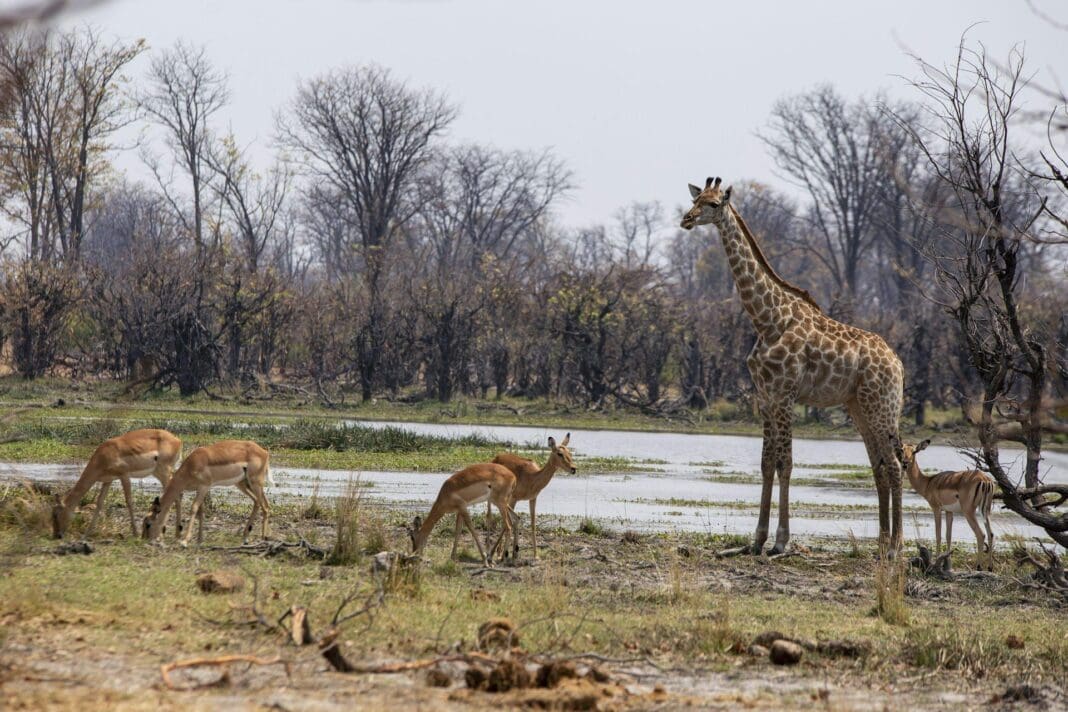Botswana’s fertile Okavango Delta is one of the last remaining high-biodiversity ecosystems in the world, home to cheetahs, African wild dogs, baobab trees, crocodiles, termites and owls that catch fish. Roughly the size of the state of Connecticut, the freshwater Okavango Delta opens into an enormous alluvial fan that stretches up to 5,800 square miles (15,000 square km) into the Kalahari Desert. The area is so vast it can be seen from space, but most people have never heard of it.
In recognition of its natural and cultural significance, the Okavango Delta was designated a UNESCO World Heritage Site in 2014. When I conducted research in the Okavango in 2024, I witnessed both its natural beauty and the ebullient warmth of the people who live there.
The health of the delta – and of 270 other natural sites across the globe – is the subject of the latest IUCN World Heritage Outlook, a recurring wellness report on the planet’s most treasured natural places.
The report’s findings are not dire, but they aren’t great, either. Many of these extraordinary places are increasingly at risk due to escalating climate change, invasive species, and a lack of consistent funding to protect them.

Every few years, the International Union for Conservation of Nature – a global contingent of more than 1,400 government agencies and private organizations focused on environmental conservation – evaluates the environmental and biological conditions at all UNESCO World Heritage sites selected for their natural significance.
That includes the Okavango Delta in Botswana, home to the world’s largest population of African elephants; the Central Amazon Conservation Complex in Brazil; the Socotra Archipelago in Yemen with hundreds of species of birds and fish; the Tropical Rainforest Heritage of Sumatra, Indonesia; the Central Amazon Conservation Complex in Brazil, and Everglades National Park, Florida.
The IUCN reports to UNESCO on each site’s current state and natural value, the threats it faces, the effectiveness of its protection and management, and actions needed to secure its future. The IUCN rates each site’s status from “good” to “critical” as a way of tracking its conservation progress over time.
The most recent report – the fourth in a series that began in 2014 – was presented at the IUCN World Conservation Congress on Oct. 11, 2025.
Overall, the report documents a decline in the conditions of these remarkable places. The proportion of World Heritage sites with a positive conservation outlook – “good” or “good with some concerns” – has dropped to 57% after remaining at 63% in 2014, 2017 and 2020. In addition, the proportion of sites considered of “significant concern” or “critical” has increased in the last five years from 37% to 43%. Many of those are in Mesoamerica, Africa and South America, as well as the Middle East, North Africa and the Mediterranean.
The report identifies several key challenges affecting heritage sites. The most widespread conservation challenge the report identifies is climate change.
Climate-related changes in biological conditions such as ocean acidity, salt concentrations, sediment buildup, droughts, flooding and groundwater flow, and variable temperatures are considered “high” or “very high” threats to 117 of the 271 heritage sites evaluated – 43% of them.
One-third of the 50 World Heritage sites that contain glaciers will see those glaciers disappear by 2050, the report projects.
Around the world, coral reefs have been, and are still, bleaching – turning white as the colorful organisms that build and inhabit them die off – affecting 30% of the 29 World Heritage-listed coral reef ecosystems.
In addition, invasive species are encroaching on World Heritage sites. For example, in Ecuador’s Galápagos Islands, invasive species like rats and feral cats are considered one of the main causes of extinctions, including to the islands’ famous birds. In Australia’s Gondwana Rainforest, the last vestiges of an ancient plant and animal “living museum” are retreating due to invading non-native species.
Additional human pressures are also endangering these unique areas. Threats to these sites from the outside include logging and mining in the region, developing nearby land, diverting natural water flows, and polluting the air, water and land. Roughly two-thirds of the sites studied face at least some danger from human activities happening outside the sites’ formal boundaries.
In addition, the report says heritage sites need more financial support to be better able to respond to key threats. It finds that most lack consistent, long-term funding for staff salaries, ecosystem monitoring, and continued maintenance of protection programs. Chronic underfunding is the primary barrier to effective ecosystem management. Funding typically comes from organizations such as the World Heritage Fund or the Global Environment Facility, an organization made up of 186 member countries, institutions, nongovernmental organizations, and the private sector that funds environmental projects worldwide.
The IUCN report warns that even effective initiatives may struggle in the long term without stronger regional, national and global support. That could include efforts like the Okavango’s Community Management of Protected Areas Conservation program, which connects rural communities and conservationists to support both people and nature.
There is good news, though. Targeted local action, such as anti-poaching efforts and local community involvement, have improved conditions at four sites in West and Central Africa, shifting their status from “critical” to “significant concern.”
There is more to know about these sites and how they are faring. As a community-based conservation scholar, I recognize that while the major drivers of ecological decline can be gleaned from published research, specific causes of that decline are best learned on the ground.
The outlook provides critical environmental trends, but it could be strengthened by including specifics based on quantitative, community-based monitoring, such as wildlife population surveys by local experts. For instance, at a conference I attended in 2024, a frog biologist from Botswana observed that, before her work, the previous frog study in that part of the delta was in 1980.
While critical local and Indigenous knowledge is recognized in the report, it is largely excluded from assessments, both because weaving it with conventional scientific analysis is difficult or because communities may choose to protect certain knowledge.
The Okavango Delta is one of many World Heritage sites, living landscapes rich with local cultural value and global significance. Like many remote heritage sites outside Europe and North America, there is a lot that remains unknown about the biodiversity in the Okavango.
The report acknowledges that recognizing the relationship between people and the environment would also improve future assessments. Overall, it offers a clear picture of global conservation trends while also acknowledging local realities and successes: for the heritage sites across the planet, conservation succeeds when people and nature thrive together.
This article is republished from The Conversation, a nonprofit, independent news organization bringing you facts and trustworthy analysis to help you make sense of our complex world. It was written by: Jessica Beaudette, Arizona State University
Read more: How the nature of environmental law is changing in defense of the planet and the climate Why protecting wildland is crucial to American freedom and identity Linking protected areas from Yellowstone to the Yukon shows the value of conserving large landscapes, not just isolated parks and preserves
Jessica Beaudette received dissertation funding from the American Association of University Women and Arizona State University for field research in Botswana. 













